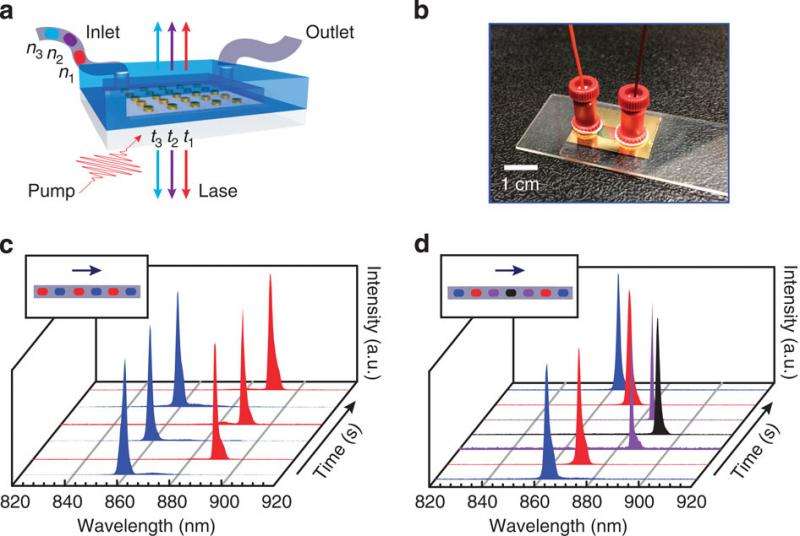April 24, 2015 report
Researchers build real-time tunable plasmon laser

(Phys.org)—A combined team of researchers from Northwestern and Duke Universities has succeeded in building a plasmon laser that is tunable in real-time. In their paper published in the journal Nature Communications, the team describes how they built their device and to what uses it might be put.
Traditionally, light can only ever be focused down to a point half the size of its frequency—aka the diffraction limit. Scientists have found a way around that limit, however, by building what are known as plasmon lasers, which are lasers that couple their beam with plasmons (oscillating surface electrons) on the surface of metals—gold for example, arranged in an array. But that approach has had its limitations as well, because it has had to rely on a solid bit of material called the gain—such lasers could not be tuned very easily, and not in real-time at all. In this new effort, the researchers report that they have found a way to use a liquid material as the gain, and because of that, are able to tune their laser in real time.
To make the new kind of laser, the team used a gold array with a plasmonic nanocavity array and a liquid dye solvent as the gain material. Doing so allows for changing the wavelength of the laser by changing the refractive index of the dye.
As the team notes, using liquid in the array has two main advantages over those based on a solid gain—the first is that they dye can be quickly dissolved in different solvents with different refractive indexes, allowing for tuning the laser in real time. The second is that because the gain is liquid, it can be fed via channel into the cavity, which allows for dynamic tuning by using different liquids.
The researchers suggest that a laser based on the one they have built could be used as part of highly sensitive sensors to note very minor changes in chemical processes—biomedical applications come to mind, such as a tool for use in early cancer detection. The team also believes their laser could be integrated with other electronics to create a lab-on-a-chip device.
More information: Real-time tunable lasing from plasmonic nanocavity arrays, Nature Communications 6, Article number: 6939 DOI: 10.1038/ncomms7939
Abstract
Plasmon lasers can support ultrasmall mode confinement and ultrafast dynamics with device feature sizes below the diffraction limit. However, most plasmon-based nanolasers rely on solid gain materials (inorganic semiconducting nanowire or organic dye in a solid matrix) that preclude the possibility of dynamic tuning. Here we report an approach to achieve real-time, tunable lattice plasmon lasing based on arrays of gold nanoparticles and liquid gain materials. Optically pumped arrays of gold nanoparticles surrounded by liquid dye molecules exhibit lasing emission that can be tuned as a function of the dielectric environment. Wavelength-dependent time-resolved experiments show distinct lifetime characteristics below and above the lasing threshold. By integrating gold nanoparticle arrays within microfluidic channels and flowing in liquid gain materials with different refractive indices, we achieve dynamic tuning of the plasmon lasing wavelength. Tunable lattice plasmon lasers offer prospects to enhance and detect weak physical and chemical processes on the nanoscale in real time.
Press release
Journal information: Nature Communications
© 2015 Phys.org





















